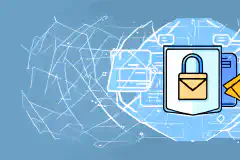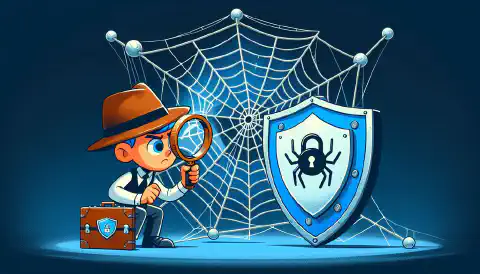10 Essential Email Security Tips: Protect Your Data and Stay Safe

Table of Contents
10 Essential Email Security Tips to Keep Your Data Safe
Email has become one of the most popular communication methods in the modern world. However, with the widespread use of email, it is also increasingly important to ensure that your data remains secure. Email security breaches can have disastrous consequences, including identity theft, financial loss, and reputational damage. In this article, we will discuss ten essential email security tips to help you keep your data safe.
Understanding the Importance of Email Security
Before we dive into the tips, let’s take a moment to understand the importance of email security. Email has become an integral part of our daily lives, and we use it for everything from personal communication to business transactions. However, with the increasing use of email, it has also become a popular target for cybercriminals seeking to steal sensitive information such as bank details, login credentials, and personal data.
Without robust email security measures, your data is vulnerable to theft, which can lead to significant consequences. Cybercriminals can use your stolen data to commit identity theft, access your financial accounts, and even take control of your email account. This can result in financial loss, loss of reputation, and legal consequences.
The Risks of Unsecured Emails
Unsecured emails can have severe consequences, and some of the most common include the following:
- Identity theft: Cybercriminals can use stolen personal information to open new accounts, apply for credit, or even file fraudulent tax returns in your name.
- Financial loss: If cybercriminals gain access to your financial accounts, they can steal your money or make unauthorized purchases.
- Email account hacking: If your email account is hacked, cybercriminals can use it to send spam or phishing emails to your contacts, or even gain access to other accounts linked to your email.
- Loss of reputation: If your email is hacked and sensitive information is leaked, it can damage your reputation both personally and professionally. This can lead to loss of trust and credibility.
With these risks in mind, let’s discuss ten essential email security tips that you can use to keep your data safe.
1. Use a Strong Password: Use a unique, complex password for your email account and change it regularly.
2. Enable Two-Factor Authentication: This adds an extra layer of security, requiring a second form of verification in addition to your password.
3. Be Cautious of Links and Attachments: Don’t click on links or download attachments from unknown senders, as they may contain malware or phishing scams.
4. Keep Your Software Up to Date: Make sure your email client and antivirus software are up to date to protect against known vulnerabilities.
5. Use Encryption: Use email encryption to protect your data in transit, making it harder for cybercriminals to intercept and read your messages.
6. Avoid Public Wi-Fi: Public Wi-Fi networks are often unsecured, making it easy for cybercriminals to intercept your data. Avoid using public Wi-Fi to access your email account.
7. Be Wary of Phishing Scams: Phishing scams are designed to trick you into giving away your personal information. Be cautious of emails that ask for personal information or login credentials.
8. Use a VPN: A virtual private network (VPN) encrypts your internet connection, making it harder for cybercriminals to intercept your data.
9. Regularly Back Up Your Data: Regularly back up your email data to protect against data loss in case of a security breach.
10. Be Vigilant: Stay vigilant and report any suspicious activity to your email provider immediately.
Strengthening Your Passwords
Your password is your first line of defense against email security breaches, and strong passwords are crucial to keeping your data safe. Here are some tips to help you create strong passwords:
Creating Complex Passwords
Your password needs to be complex enough to withstand brute force attacks, which are a common method used by cybercriminals to steal passwords. A strong password should:
- Be at least eight characters long.
- Include numbers, symbols, and upper and lower case letters.
- Avoid using common phrases or names.
To create a strong and memorable password, consider using a passphrase. A passphrase is a combination of words that are easy for you to remember, but difficult for others to guess. For example, “purpleelephantshavebigears” is a strong passphrase that meets all of the criteria for a strong password.
Another way to create a strong password is to use a random password generator. Many password managers have this feature built in, and it can be a great way to create a unique and complex password that you don’t need to remember.
Using a Password Manager
Password managers are tools that generate and store complex passwords securely. They also make it easy to use unique passwords for each of your accounts, which is crucial to preventing data breaches. With a password manager, you only need to remember one master password to access all of your other passwords.
When choosing a password manager , look for one that has strong encryption and two-factor authentication . This will ensure that your passwords are protected even if your password manager is hacked.
Enabling Two-Factor Authentication
Two-factor authentication is an additional layer of security that requires a second form of identification, such as a code sent to your phone or email, before granting access to your email account. Enabling two-factor authentication can help prevent unauthorized access to your account, even if your password is compromised.
Many email providers, such as Gmail and Yahoo, offer two-factor authentication as an option. To enable two-factor authentication, go to your email account settings and look for the security or two-factor authentication options.
By following these tips, you can create strong passwords and protect your email account from cybercriminals. Remember to update your passwords regularly and never reuse the same password for multiple accounts.
Identifying and Avoiding Phishing Scams
Phishing scams are tactics used by cybercriminals to trick users into providing sensitive information, such as login credentials and personal data. These scams are becoming increasingly sophisticated and can be difficult to detect. It is important to stay vigilant and take necessary precautions to protect your personal information. Here are some tips to identify and avoid phishing scams:
Recognizing Phishing Emails
Phishing emails are designed to look like legitimate emails and often include a sense of urgency to try to trick the recipient into taking immediate action. Be wary of emails that:
- Ask for personal information, such as login credentials or bank details. Legitimate companies will never ask for this information via email.
- Contain suspicious links or attachments. These links may lead to fake websites that look like the real thing, but are designed to steal your information.
- Impersonate a company or individual that you know. Cybercriminals often use logos and branding of well-known companies to make their emails appear legitimate.
If you receive an email that you suspect may be a phishing attempt, do not click on any links or provide any personal information. Instead, contact the company or individual directly to confirm the legitimacy of the email.
Verifying the Sender’s Identity
Always verify the sender’s identity before you provide any personal or sensitive information. You can directly contact the company or individual to confirm that they sent the email. Look for contact information on the company’s official website, rather than relying on information provided in the email.
Another way to verify the sender’s identity is to look at the email address. Cybercriminals often use email addresses that are similar to legitimate ones, but with slight variations. For example, they may use “ [email protected] ” instead of “ [email protected] ”. Always double-check the email address before responding to an email.
Reporting Suspicious Emails
If you receive a suspicious email, report it to your email provider to help them prevent similar scams from happening to others. Most email providers have a way to report phishing emails, which can help them identify and block these types of messages in the future.
By staying vigilant and following these tips, you can protect yourself from falling victim to a phishing scam. Remember, if an email looks suspicious, it probably is. Always err on the side of caution and take necessary precautions to keep your personal information safe.
Securing Your Email Account
Securing your email account is essential to prevent unauthorized access and protect your data. Email accounts are often used to store sensitive information, such as personal conversations, financial information, and confidential work-related data. Here are some tips to secure your email account:
Using Encrypted Email Services
Encrypted email services use complex algorithms to scramble your data, making it difficult for cybercriminals to access. Consider using encrypted email services to add an extra layer of security to your email communication. Some popular encrypted email services include ProtonMail, Tutanota, and Hushmail.
It’s important to note that both the sender and recipient need to be using the same encrypted email service for the encryption to work. Encrypted email services also have limitations, such as not being able to send encrypted emails to non-encrypted email addresses.
Regularly Updating Your Email Software
Email software updates often contain critical security patches that protect you from vulnerabilities. Ensure that you regularly update your email software to the latest version. This will ensure that you have the latest security features and that any known security issues have been patched.
It’s also important to keep your operating system up to date, as email software is often integrated with the operating system. This means that vulnerabilities in the operating system can also affect your email security.
Disabling Automatic Image Loading
Automatic image loading can be used to track your activity and vulnerabilities in your email software. Consider disabling automatic image loading to improve your email security. This will prevent images from loading automatically when you open an email, and you will have the option to load them manually if necessary.
It’s also important to be cautious when opening attachments or clicking on links in emails, especially if they are from unknown senders. These can contain malware or phishing scams that can compromise your email security.
By following these tips, you can improve the security of your email account and protect your sensitive information from cyber threats.
Protecting Sensitive Information
Sensitive information, such as your bank details, personal data, and login credentials, are lucrative targets for cybercriminals. Protecting this information is crucial to prevent identity theft, financial fraud, and other cybercrimes. Here are some tips to help you protect sensitive information:
Avoiding Public Wi-Fi Networks
Public Wi-Fi networks are often unsecured and can be exploited by cybercriminals to gain access to your personal data. Consider avoiding public Wi-Fi networks and using a secure connection instead. If you must use a public Wi-Fi network, use a Virtual Private Network (VPN) to encrypt your data and protect your privacy.
Using a Virtual Private Network (VPN)
A VPN is a tool that encrypts your data and routes it through a secure network. By using a VPN, you can create a secure connection and keep your personal data safe. A VPN is especially useful when you are using a public Wi-Fi network, as it encrypts your data and protects your privacy.
Limiting the Sharing of Personal Information
Limit the amount of personal information that you share online and avoid using social media to share sensitive information. Be cautious when sharing personal information online, and only share what is necessary. Avoid sharing sensitive information, such as your Social Security number, bank account details, and login credentials, online. If you must share sensitive information, use a secure connection and verify the identity of the recipient.
By following these tips, you can protect your sensitive information and prevent cybercrime. Remember to stay vigilant and keep your security software up to date to stay protected against the latest threats.
Educating Your Team on Email Security
Educating your team on email security is not just a good practice, it is essential to establish a culture of security within your organization. Cybersecurity threats are becoming more sophisticated and frequent, making it important to take every precaution necessary to protect your company’s sensitive data.
When it comes to email security, your employees are the first line of defense. Therefore, it is crucial to educate your team on email security best practices.
Implementing Email Security Training
One of the most effective ways to educate your team on email security is to provide regular training sessions. These sessions should cover the latest email security threats and teach your employees how to recognize and avoid them. Additionally, the training should include best practices for creating strong passwords, identifying suspicious emails, and reporting any security incidents.
Establishing Clear Security Policies
Another critical step in educating your team on email security is to establish clear security policies. These policies should outline the company’s expectations for email usage and provide guidelines for how to handle sensitive information. Additionally, the policies should include consequences for violating the policies, such as disciplinary action or termination.
Encouraging Open Communication About Security Concerns
Finally, it is important to encourage open communication about security concerns within your team. Employees should feel comfortable reporting any suspicious emails or security incidents without fear of retribution. This will allow your team to work together to identify and prevent potential security threats.
In conclusion, educating your team on email security is a critical step in protecting your company’s sensitive data. By implementing regular training sessions, establishing clear security policies, and encouraging open communication, you can create a culture of security within your organization and reduce the risk of cyber attacks.
Regularly Monitoring and Reviewing Your Email Security
Regularly monitoring and reviewing your email security is a crucial aspect of protecting your sensitive information from cybercriminals. With the rise of cyber threats, it is imperative to be proactive and vigilant to avoid becoming a victim of an email breach. Here are some tips to help you stay on top of your email security:
Conducting Security Audits
Conducting regular security audits is a fundamental step in identifying any potential vulnerabilities and addressing them before they can be exploited. A security audit involves reviewing your email security policies, procedures, and technologies to ensure they are up to date and effective. By conducting a security audit, you can identify gaps in your security measures and take corrective actions to mitigate the risks.
For example, you can review your email security protocols, such as spam filters like SpamAssassin or Barracuda , antivirus software like McAfee or Symantec , firewalls like Cisco ASA , and encryption methods like Pretty Good Privacy (PGP) . Additionally, you can assess your employees’ awareness of email security best practices and provide training to address any knowledge gaps.
Staying Informed on the Latest Threats
Staying informed about the latest threats and vulnerabilities is essential to prevent email security breaches. Cybercriminals are continually developing new tactics to exploit vulnerabilities in email systems, and it is crucial to stay up to date with the latest trends. One way to stay informed is by subscribing to security newsletters and blogs that provide timely information and insights on emerging threats.
For example, you can subscribe to threat intelligence platforms like Symantec Threat Intelligence or Trend Micro Research to receive real-time updates on the latest threats. You can also participate in industry forums and attend webinars to gain knowledge and share best practices with other professionals.
Continuously Improving Your Security Measures
Continuously improving your security measures is vital to ensure that your email security is always up to date. With the rapid advancements in technology, cybercriminals are continually finding new ways to exploit vulnerabilities. Therefore, it is essential to adopt new technologies and best practices to stay ahead of the curve.
One way to improve your email security is by implementing multi-factor authentication (MFA) to verify user identities. MFA is an effective way to prevent unauthorized access to your email system and ensure that only authorized personnel can access sensitive information. Many email providers and services offer MFA options, such as Google Workspace and Microsoft 365 .
You can also consider using email encryption to protect your messages from interception and unauthorized access. Email encryption ensures that your messages are only accessible to the intended recipient, and no one else can read them. Popular email encryption solutions include Virtru and Zix .
In conclusion, regularly monitoring and reviewing your email security is crucial to protect your sensitive information from cybercriminals. By conducting security audits, staying informed about the latest threats, and continuously improving your security measures, you can mitigate risks and safeguard your email system.
Conclusion
Email security is crucial to protecting your personal and sensitive data from cybercriminals. By implementing these ten essential email security tips, you can significantly reduce the risk of data breaches and keep your data safe. Remember, it is always better to be safe than sorry, so take the necessary steps to secure your email account today!






